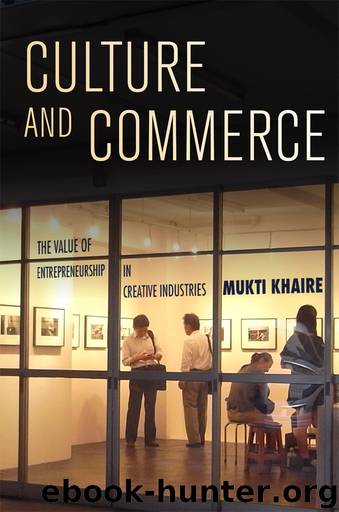Culture and Commerce by Mukti Khaire

Author:Mukti Khaire [Khaire, Mukti]
Language: eng
Format: epub
Publisher: Stanford University Press
Published: 2017-02-27T16:00:00+00:00
7
POWER AND UNPREDICTABILITY
Key Challenges Facing Producers
A new star—or new stars—may emerge. That’s not only unpredictable; it’s somewhat out of [their] hands. All they can do is put the best people in position and let them do their jobs. Good things are very likely to follow.
—Margaret Sullivan1
Gabrielle “Coco” Chanel, the iconic founder of the House of Chanel, created what are now considered the classic fixtures of a modern woman’s wardrobe—the little black dress, Chanel No. 5 perfume, and the cardigan jacket—all of which were dramatic departures from the norms of women’s fashion during the first half of the twentieth century when these designs were first introduced.2 Despite the revolutionary nature of her designs, Chanel’s work prevailed to such an extent that, when she passed away in 1971, her firm had been successful and well known for more than fifty years. Her aesthetic—modern, simple but stylish, and minimalist—changed the way women dressed in the twentieth century. Both customers and fashion writers heaped lavish admiration on her designs, which spawned many imitations.
Although the firm was in a reasonably healthy financial state at the time of Chanel’s death, ten years later in 1981 the House of Chanel was struggling to regain its cultural dominance and financial strength. Certainly, it is natural for a fashion firm to lose its direction to a certain extent after the founding designer leaves, especially when the founder is someone of Coco Chanel’s stature. However, it is notable that even a firm with a very strong reputation and good designers at its helm struggled after losing its original iconic designer. Despite the firm’s long-term success and cultural impact, after Chanel’s death it received little to no benefit of the doubt from stakeholders—including consumers and fashion journalists/reviewers—on account of its association with the acclaimed Coco Chanel. Its brand and reputation may have kept the firm alive, but they were insufficient to support the thriving success to which the firm was accustomed.
The case of Coco Chanel and her firm exemplifies the challenges that are common to all producers in creative industries. Due to the nature of creative industries and creators, the characteristics of (markets for) cultural goods, and consumers’ resistance to novel cultural goods, producers operate in environments of extreme uncertainty and must typically forego substantial control over their destinies. Of course, firms in other industries also face constrained agency and limited influence over how they are perceived and evaluated by audiences and stakeholders, including customers. In the creative industries, however, the constraints are particularly severe because (among other factors) consumer tastes are inherently volatile and subjective,3 intermediaries have a strong effect on markets for cultural goods but are beyond the influence of producers,4 and cultural products have high symbolic value.5 Fundamentally (as described in Chapter 6), producers in creative industries are subject to challenges that result from their position at the cusp of the cultural and commercial worlds, which are in tension with each other.6
Because the realms of culture and commerce have distinct conventions of worth and therefore different criteria for
Download
This site does not store any files on its server. We only index and link to content provided by other sites. Please contact the content providers to delete copyright contents if any and email us, we'll remove relevant links or contents immediately.
| Advertising | Consumer Behavior |
| Customer Service | Marketing |
| Public Relations | Sales & Selling |
| Search Engine Optimization |
Influence: The Psychology of Persuasion by Robert B. Cialdini(4716)
The Miracle Morning by Hal Elrod(4640)
The Hacking of the American Mind by Robert H. Lustig(4319)
Pre-Suasion: A Revolutionary Way to Influence and Persuade by Robert Cialdini(4153)
Unlabel: Selling You Without Selling Out by Marc Ecko(3592)
Ogilvy on Advertising by David Ogilvy(3518)
Hidden Persuasion: 33 psychological influence techniques in advertising by Marc Andrews & Matthijs van Leeuwen & Rick van Baaren(3476)
Purple Cow by Seth Godin(3143)
Who Can You Trust? by Rachel Botsman(3089)
Kick Ass in College: Highest Rated "How to Study in College" Book | 77 Ninja Study Skills Tips and Career Strategies | Motivational for College Students: A Guerrilla Guide to College Success by Fox Gunnar(3077)
The Marketing Plan Handbook: Develop Big-Picture Marketing Plans for Pennies on the Dollar by Robert W. Bly(2978)
This Is Marketing by Seth Godin(2974)
I Live in the Future & Here's How It Works by Nick Bilton(2938)
The Power of Broke by Daymond John(2900)
Building a StoryBrand by Donald Miller(2843)
The Tipping Point by Malcolm Gladwell(2829)
The 46 Rules of Genius: An Innovator's Guide to Creativity (Voices That Matter) by Marty Neumeier(2799)
Draw to Win: A Crash Course on How to Lead, Sell, and Innovate With Your Visual Mind by Dan Roam(2740)
Market Wizards by Jack D. Schwager(2645)
